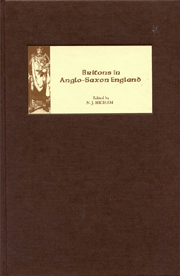Book contents
- Frontmatter
- Contents
- List of Illustrations
- List of Tables
- Contributors
- Dedication
- Acknowledgements
- Abbreviations
- 1 Britons in Anglo-Saxon England: An Introduction
- 2 Anglo-Saxon Attitudes
- 3 Forgetting the Britons in Victorian Anglo-Saxon Archaeology
- 4 Romano-British Metalworking and the Anglo-Saxons
- 5 Invisible Britons, Gallo-Romans and Russians: Perspectives on Culture Change
- 6 Historical Narrative as Cultural Politics: Rome, ‘British-ness’ and ‘English-ness’
- 7 British Wives and Slaves? Possible Romano-British Techniques in ‘Women's Work’
- 8 Early Mercia and the Britons
- 9 Britons in Early Wessex: The Evidence of the Law Code of Ine
- 10 Apartheid and Economics in Anglo-Saxon England
- 11 Welsh Territories and Welsh Identities in Late Anglo-Saxon England
- 12 Some Welshmen in Domesday Book and Beyond: Aspects of Anglo-Welsh Relations in the Eleventh Century
- 13 What Britons Spoke around 400 AD
- 14 Invisible Britons: The View from Linguistics
- 15 Why Don't the English Speak Welsh?
- 16 Place-Names and the Saxon Conquest of Devon and Cornwall
- 17 Mapping Early Medieval Language Change in South-West England
- Index
3 - Forgetting the Britons in Victorian Anglo-Saxon Archaeology
Published online by Cambridge University Press: 12 September 2012
- Frontmatter
- Contents
- List of Illustrations
- List of Tables
- Contributors
- Dedication
- Acknowledgements
- Abbreviations
- 1 Britons in Anglo-Saxon England: An Introduction
- 2 Anglo-Saxon Attitudes
- 3 Forgetting the Britons in Victorian Anglo-Saxon Archaeology
- 4 Romano-British Metalworking and the Anglo-Saxons
- 5 Invisible Britons, Gallo-Romans and Russians: Perspectives on Culture Change
- 6 Historical Narrative as Cultural Politics: Rome, ‘British-ness’ and ‘English-ness’
- 7 British Wives and Slaves? Possible Romano-British Techniques in ‘Women's Work’
- 8 Early Mercia and the Britons
- 9 Britons in Early Wessex: The Evidence of the Law Code of Ine
- 10 Apartheid and Economics in Anglo-Saxon England
- 11 Welsh Territories and Welsh Identities in Late Anglo-Saxon England
- 12 Some Welshmen in Domesday Book and Beyond: Aspects of Anglo-Welsh Relations in the Eleventh Century
- 13 What Britons Spoke around 400 AD
- 14 Invisible Britons: The View from Linguistics
- 15 Why Don't the English Speak Welsh?
- 16 Place-Names and the Saxon Conquest of Devon and Cornwall
- 17 Mapping Early Medieval Language Change in South-West England
- Index
Summary
We derive our antiquities of the period of Anglo-Saxon paganism from on source, the graves.
HOW we explain the origins and development of furnished burial rites in southern and eastern England dated to the fifth and sixth centuries AD is the focus of ongoing debate and controversy. Currently, archaeologists and historians have various answers to this question, from the adoption of Germanic ‘fashions’ by indigenous Britons to a mass-migration of Germanic settlers. Many scholars opt for different points on a spectrum between these extremes, including the settlement, accommodation and interaction of Germanic groups with Britons on a local level and the invasion and subsequent imitation of Germanic warrior elites. In contrast, some writers opt out of the debate by arguing that furnished burial is unequivocally ‘Germanic’, whether this be in terms of biological origins, linguistic connections, cultural affiliations or political hegemony. Yet even if archaeologists and historians sometimes have different answers, they share a common interest in the same question, but it is a question that has two sides. While traditionally we have used furnished graves to address the question ‘When and where did the Anglo-Saxons settle?’, the flip-side of the same question is ‘What happened to the Britons?’
As a contribution to this ongoing historical and archaeological research, this paper aims to return to the very origins of this debate: the study of early medieval graves by Victorian archaeologists.
- Type
- Chapter
- Information
- Britons in Anglo-Saxon England , pp. 27 - 41Publisher: Boydell & BrewerPrint publication year: 2007



